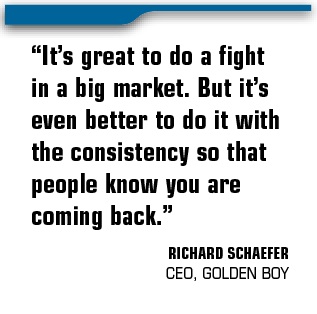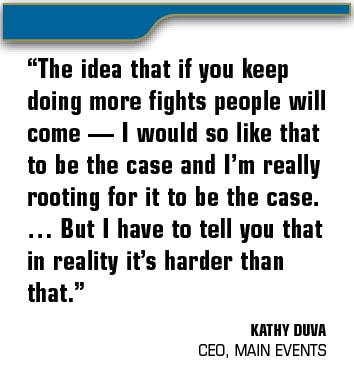Brooklyn-born welterweight Paulie Malignaggi scanned the rollicking Barclays Center crowd from his ringside seat and smiled, soaking in the thunderous chant of “B-Hop, B-Hop, B-Hop” that echoed through the building.
“You never hear Bernard Hopkins cheered like this,” Malignaggi said after watching Hopkins, who is 48, become the oldest fighter to win a world championship last month. “The fans showed tonight that they want boxing here. If you market it the right way, you’ll bring them out. You just need to have a consistent presence.”
New York is unparalleled as a fight town when it comes to its history, which winds back to the late 1880s and the bare-knuckle bouts of John L. Sullivan at the then open-air Madison Square Garden.
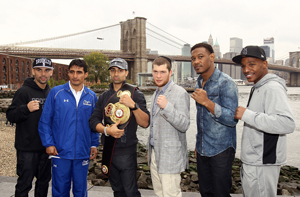 |
Boxers pose in front of the Brooklyn Bridge for a publicity photo in October prior to a fight night at Barclays Center.
Photo by: Getty Images |
Joe Louis fought in the large venues of New York City 25 times, packing the Garden, Yankee Stadium and the Polo Grounds. Rocky Marciano graced those three fabled spots a combined 10 times. Sugar Ray Robinson fought at the Garden 23 times. Muhammad Ali fought there eight times and at Yankee Stadium once.
Ali’s last fight in New York was more than 30 years ago, and the rest of those iconic stars retired long before that. Over the decades, the pipeline of big fights in New York City has slowed for a variety of reasons, some cyclical, some financial, some cultural.
The casinos of Las Vegas now are home to most of boxing’s biggest bouts. The next tier frequently land in Atlantic City, or in any number of casino ballrooms on Native American land.
Since 2008, only Puerto Rican star Miguel Cotto has played the Garden’s main building. Every other fight has been in the adjacent Theater at Madison Square Garden, which seats about 5,600 and, because of renovations, hosted only three fights in the last two years.
It has been a span of relative slumber for boxing in New York. And then, as the calendar turned this year, things began to percolate.
On Saturday afternoon, NBC was set to air heavyweights Tyson Fury and Steve Cunningham from the Theater at MSG, which also hosted an HBO show in January. The Saturday before that, HBO aired promoter Top Rank’s Guillermo Rigondeaux vs. Nonito Donaire fight from sold-out Radio City Music Hall. This coming Saturday brings the third card held at Barclays Center since the building launched its boxing program in October. The event, which airs on Showtime, features a heavy Brooklyn flavor, headlined by popular hometown lightweight Zab Judah against Danny Garcia.
Boxing also is on the Barclays Center’s calendar in June, when Malignaggi fights rising star Adrien Broner, and July,
when Hopkins is slated to be back against little-known German Karo Murat.
“You’ve got to get people conditioned to know that boxing is in Brooklyn,” said Brett Yormark, CEO of the Brooklyn Nets and Barclays Center, who envisioned boxing as tent-pole programming for the arena from the time developers put the first shovel in the ground. “Doing it sporadically doesn’t accomplish it. So our goal is to have regularly scheduled events. We have to re-engage the boxing fan.”
The steady flow of Brooklyn fights comes as a result of the venue’s three-year deal with Los Angeles-based promoter Golden Boy, which will use the venue to develop a home base for fighters on the East Coast.
“There haven’t been any (big-arena) fights for a long time in Brooklyn,” said Golden Boy CEO Richard Schaefer. “So we look at this the way you do when you build a business. … You have to expose the people to your product.
“It’s great to do a fight in a big market. But it’s even better to do it with the consistency so that people know you are coming back.”
Only two events in, it’s too early to tell how the market is taking to the program.
The Hopkins fight generated a $611,974 gate from 9,377 tickets sold. The debut card, which Golden Boy and the Barclays Center seeded by giving away as many 1,000 tickets to anyone who showed an ID with a Brooklyn address, sold 9,635 tickets and did a gate of about $750,000. This week’s fight paced ahead of the other two, with about 6,000 tickets sold even before the lights came on for the Hopkins fight.
“The idea that if you keep doing more fights people will come — I would so like that to be the case and I’m really rooting for it to be the case,” said Kathy Duva, CEO of Main Events, which promoted the NBC fight at MSG and has tried a similar tack with boxing at the Prudential Center in Newark, N.J. “It certainly is logical. But I have to tell you that in reality it’s harder than that.
“At the Pru Center, they continue to do everything they possibly can do to help us sell tickets. But we’ve found that going in there more than two or three times a year is overdoing it.
“Consistency is good. But you also have to know when enough is enough.”
Barclays Center puts on the gloves
Holding court in a bunker suite in the bowels of the Barclays Center a couple of hours before Hopkins made history, an occasional roar seeping through the walls as a parade of Brooklyn fighters slugged it out on the undercard, Yormark sat down to explain his vision for bringing big-event boxing to New York’s most populous borough.
He was reaching for a bowl of assorted nuts when a Nets executive strode in with news from the ring.
“Your guy looked pretty good,” Nets chief administrative officer Leo Ehrline said to Yormark.
“Which one?” Yormark said.
“The one you ran across the bridge with,” Ehrline replied.
“Oh, Frank Galarza? He won?”
“He knocked the guy out.”
Yormark nodded his approval.
It is unlikely that Galarza ever will emerge as a headliner, especially at a building the size of the Barclays Center. But, like many boxers, he comes with the sort of compelling back story that can generate coverage for the fights. His father died a violent death when he was a child. His mother overdosed a couple of years later. Galarza runs across the Brooklyn Bridge each day to his job as a personal trainer. One morning, Yormark ran with him.
Now, he’s rooting for him.
“We wanted to both grow the local talent and stage events that have national appeal,” Yormark said, settling back into the conversation. “So far, it’s unfolding the way we’d hoped.”
The first event, telecast by Showtime, had Danny Garcia of Philadelphia as the co-feature and Devon Alexander of St. Louis as the first televised fight, but the meat of the local promotion leading up to the fight came from Malignaggi and a popular up-and-coming New York middleweight, Peter “Kid Chocolate” Quillin. Mike Tyson, from Brooklyn’s Brownsville section, was at ringside.
For the second fight, they went with Hopkins, a Philadelphia fighter whose story line as a man making history appealed to the broader sports audience. The third fight brought in Judah, likely the most popular of the current Brooklyn fighters, to fight Garcia.
The idea is to blend fighters with local connections with those who aren’t local, but might develop a local following if they turn the arena into their home base.
“A local major league baseball team or NFL team can have a home team following, but it’s hard to develop that for an individual athlete that’s fighting twice a year,” said Ken Hershman, president of HBO Sports, the premium cable network that, along with rival Showtime, provides the economic engine for boxing in the U.S. “This is a great effort to make a connection between the athlete and the community.
“To really sell tickets, there’s got to be a connection — something that fans say, ‘That really resonates with me.’ And it’s getting harder and harder. So you need to develop it carefully, and preferably locally, where the fighter is connecting in the community. Do that and then you’ll have a real place where you can keep coming back.”
On that front, the deal between the arena and Golden Boy places expectations on both sides. A year before the building had opened, Golden Boy began investing in fighters that made sense for the market, adding Malignaggi and Quillin to a stable that already included another Brooklyn-born fighter, Danny Jacobs.
During this NBA season, Malignaggi, Quillin and Jacobs all have been courtside at Nets games, where they’ve been shown on the video screen, backed by a reminder to fans to buy tickets for their fights. The Nets have supplied fighters with logo caps and jerseys in the hope that it will deepen their connection to the overall brand.
For the first fight, Showtime got involved in the marketing. Schaefer arranged a meeting between the head of the network’s sports division, Stephen Espinoza, and Yormark. They crafted a plan to jointly advertise the event, featuring both Showtime and the Barclays Center.
“It’s something that doesn’t usually happen,” Espinoza said. “Usually you advertise either the broadcast or the ticket sales. We worked together to market the message consistently, so we would both benefit. It’s little things like that that show the partnership that we’re all trying to build.”
Though early in the process, the Barclays marketing staff has begun compiling a database of ticket buyers and prospects. One key takeaway is that only 1,146 buyers have purchased tickets to both fights, indicating that, at least initially, the market is more segmented than one might expect.
Buyers for the first two fights were 70 percent male, with an average age of 42.8, and 46 percent were married.
Twenty-six percent of buyers reported household incomes of $50,000 to $75,000 and 17 percent earned more than $125,000. Their music preferences skewed toward rock/pop, hip-hop and R&B. Their sports preferences were basketball and football.
While promoters typically have some of that information about their buyers, they rarely can market to them with the effectiveness and efficiency of a venue that will dedicate the resources to do so.
“We’re still trying to figure out how to organically get to the customer,” said Sean Saadeh, vice president of programming for the Barclays Center, who serves as the conduit between the arena and promoters. “Some of that is through word of mouth, but it’s also social network and database building. We’re working fiercely to build it to a level where we’ve created hard-core boxing fans who feel like they’ve got to come back every single time.”
Managing expectations
When the two parties signed the three-year agreement in 2010, they envisioned a monthly fight rotation at Barclays Center, with one-third to half of those dedicated to developmental cards that would air on ESPN, Fox Sports Net and Spanish-language cable. They talked about scaling the building down to a few thousand seats or less.
As the arena schedule came together, it became clear that those dates would be harder to come by than expected. The upcoming move of the Islanders to Brooklyn will further reduce availability. Rather than a dozen cards, it now looks like the arena will cap out at eight a year, or even six.
Yormark still wants to see Golden Boy develop young, local fighters in the building. But it will be done on the undercard of bigger fights, rather than on smaller shows. The goal is for those fighters to eventually matriculate to the top of the card.
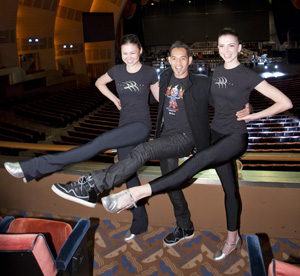 |
The Rockettes joined boxer Nonito Donaire to promote this month's bout at Radio City.
Photo by: Madison Square Garden |
To create a grassroots element similar to the high school and college basketball events that the Barclays Center hosts, Yormark landed the finals of the New York Golden Gloves amateur tournament, which had been at Madison Square Garden since its founding in 1927.
Yormark grew up going to fights. His twin brother, Michael, interned in the boxing department at MSG years ago. Still, Brett Yormark said he had only a cursory understanding of the business when he decided to make boxing a regular part of the building menu. The one thing he knew was that he wanted a single promoter he could rely on to be responsible for the flow of shows. For counsel, he turned to Tim Leiweke, the former CEO of AEG, which owns a stake in Golden Boy and has provided a consistent home for the promoters’ fights at its venues, including Staples Center.
“I don’t understand that world,” Yormark said he told Leiweke, “but I do know that I need to align myself with someone who if they tell me something on Monday, it’s going to be the same thing on Friday. And I know that in boxing that hasn’t always been the case.”
Yormark said Leiweke recommended Schaefer.
While executives from both Golden Boy and Barclays call the deal a partnership, the financial structure for most fights will be similar to those at venues where there isn’t a long-term contractual relationship.
Golden Boy takes all the revenue from ticket sales, TV rights and the national sponsorships that it sells. Barclays Center makes its money from rent, concessions, local sponsorships and some club and suite rentals. The venue may have to pay a guarantee in order to compete for some of the bigger fights, as sources said it did to bring in Hopkins, but that won’t be the norm.
While Schaefer said Golden Boy does “four wall” rentals for almost all its events, he said he wondered whether the practice was the right way to go when he was going to be a frequent provider of fights for one building. When he deals with AEG, which is a Golden Boy investor, the venues have skin in the game.
“(Barclays Center has) the resources, but I was worried about whether they really would use them to push our tickets,” said Schaefer, who initially told Yormark he wouldn’t do fights there without a guarantee. “When I got to know them a little bit, I said, ‘Let’s try.’ If I see that they’re not going to support us the way they can, pushing the tickets, then we’ll have to change that. But so far, so good.”
Yormark and Saadeh said it only makes sense for them to put resources behind selling the fights, not only because bigger crowds buy more concessions, but also because they are trying to build something sustainable.
Most of the events at Barclays fit into one of four platforms. Brooklyn Hoops starts with the Nets, but also includes college and high school basketball. Brooklyn Show is all the concerts. Brooklyn Family is the circus and other similar events. And then there’s Brooklyn Boxing.
“Boxing is a platform within our brand, so if boxing doesn’t do well, it hurts our brand,” Saadeh said. “We want to be successful whether we’re at risk or not. And the way we look at it, we are at risk. The last thing we need is for our programming partners to fail. Because if they fail they don’t do it again. And then what happens to our boxing program?”
MSG goes toe to toe
Across the Brooklyn Bridge, the man who oversees boxing at Madison Square Garden ran down the benefits that a date at the venue affords a promoter, everything from placement on a famed marquee on one of the city’s most-trafficked corridors, to fighter appearances at Knicks and Rangers games, to a database of ticket buyers that goes back for decades,
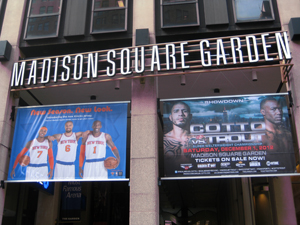 |
Madison Square Garden still considers itself to be the mecca of boxing.
Photo by: Madison Square Garden |
to access to a group sales staff.
“We’re fortunate because we’re the mecca of boxing and have been forever,” said Joel Fisher, executive vice president of MSG Sports. “We’ve got great lists. There is the general boxing list of ticket buyers. There also are ethnic groups that buy tickets for different fighters. We have all of that. That gives promoters a head start in terms of selling tickets.”
The tactics sound similar to those the Barclays Center has employed thus far. Fisher said MSG rolls them out for every promoter that brings a fight to the building.
That being the case, some in boxing wonder whether it makes sense for a promoter to lock into one venue for most of its fights, or for a venue to tie to a single promoter.
“New York is always, always, always an incredible market for boxing,” said Todd DuBoef, president of Top Rank, which sold out 5,600-seat Radio City Music Hall for its fight April 13, doing a gate of about $400,000. “But in my business model, my partner is the market, not a building. Therefore I feel that while New York is an important part of boxing in its totality, I don’t believe it’s building-centric. The support of a building is great, especially when you’re talking about a building that is forward-thinking and proactive about helping you promote. But I don’t believe buildings drive markets. I believe it’s always about promotion and content. And that really comes back to what we do as promoters.”
Duva, the CEO of Main Events, said she sees merit in a connection between a promoter and a venue. She said she had similar ideas when she started doing fights at the Prudential Center in 2009.
They planned to do smaller shows with a scaled-down seating bowl as a grassroots means of developing and engaging fight fans. Those went by the wayside once the building began attracting more concerts and other events.
They developed a legitimate headliner for the building in heavyweight Tomasz Adamek, who made himself visible around Newark and sold well with the local Polish-American community. But Adamek’s career is on the wane now, and Main Events hasn’t yet found a fighter who can replace him as a sales driver in Newark.
The tactics seemed sound. But the returns weren’t enough to justify putting more boxing on the menu.
“We marketed to the season-ticket holders and we brought fighters to games and we did everything else you could do,” Duva said. “Having access to all those people is terrific. But we found out that being a hockey fan does not necessarily translate to being a fight fan. The support of the venue is great, and we certainly got it.
“If the building is going to take ownership of that and go out and do it, that is a wonderful thing. They’re there all the time. They have the database. They have access to people. It’s all great. But you still have to convince people to spend their money to go see a fight.”



